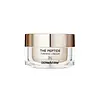What's inside
What's inside
 Key Ingredients
Key Ingredients

 Benefits
Benefits

 Concerns
Concerns

No concerns
 Ingredients Side-by-side
Ingredients Side-by-side

Water
Skin ConditioningDipropylene Glycol
HumectantCaprylic/Capric Triglyceride
MaskingCetearyl Alcohol
EmollientIsononyl Isononanoate
EmollientGlycerin
HumectantCetearyl Olivate
Polypropylsilsesquioxane
Sorbitan Olivate
Emulsifying1,2-Hexanediol
Skin ConditioningPanthenol
Skin ConditioningSimethicone
EmollientSodium Polyacryloyldimethyl Taurate
Emulsion StabilisingParfum
MaskingEthylhexyl Olivate
Skin ConditioningAllantoin
Skin ConditioningEthylhexylglycerin
Skin ConditioningSodium Acrylates Copolymer
Butylene Glycol
HumectantHydrolyzed Rice Protein
Skin ConditioningPolyglyceryl-4 Oleate
EmulsifyingAdenosine
Skin ConditioningCoptis Japonica Root Extract
Skin ConditioningDisodium EDTA
Arginine/Lysine Polypeptide
Skin ConditioningAcetyl Hexapeptide-8
HumectantSodium Hyaluronate
HumectantHydrogenated Lecithin
EmulsifyingPalmitoyl Tripeptide-1
Skin ConditioningHydrogenated Phosphatidylcholine
EmulsifyingCyanocobalamin
Skin ConditioningPalmitoyl Pentapeptide-4
Skin ConditioningCholesterol
EmollientCeramide NP
Skin ConditioningPotassium Cetyl Phosphate
EmulsifyingBetaine
HumectantSodium Surfactin
CleansingWater, Dipropylene Glycol, Caprylic/Capric Triglyceride, Cetearyl Alcohol, Isononyl Isononanoate, Glycerin, Cetearyl Olivate, Polypropylsilsesquioxane, Sorbitan Olivate, 1,2-Hexanediol, Panthenol, Simethicone, Sodium Polyacryloyldimethyl Taurate, Parfum, Ethylhexyl Olivate, Allantoin, Ethylhexylglycerin, Sodium Acrylates Copolymer, Butylene Glycol, Hydrolyzed Rice Protein, Polyglyceryl-4 Oleate, Adenosine, Coptis Japonica Root Extract, Disodium EDTA, Arginine/Lysine Polypeptide, Acetyl Hexapeptide-8, Sodium Hyaluronate, Hydrogenated Lecithin, Palmitoyl Tripeptide-1, Hydrogenated Phosphatidylcholine, Cyanocobalamin, Palmitoyl Pentapeptide-4, Cholesterol, Ceramide NP, Potassium Cetyl Phosphate, Betaine, Sodium Surfactin
Water
Skin ConditioningDimethicone
EmollientSqualane
EmollientGlycerin
HumectantPyrus Malus Fruit Extract
Skin ConditioningPentylene Glycol
Skin ConditioningCeramide AP
Skin Conditioning1,2-Hexanediol
Skin ConditioningAmmonium Acryloyldimethyltaurate/Vp Copolymer
Butylene Glycol
HumectantHydroxyacetophenone
AntioxidantSodium Acrylates Copolymer
Acrylates/C10-30 Alkyl Acrylate Crosspolymer
Emulsion StabilisingGigartina Stellata Extract
Skin ProtectingAcetyl Sh-Hexapeptide-5 Amide Acetate
Skin ConditioningTridecapeptide-1
Skin ConditioningOligopeptide-1
Skin ConditioningSodium Phytate
Propanediol
SolventLecithin
EmollientHydroxypropyltrimonium Hyaluronate
Cyanocobalamin
Skin ConditioningPhenoxyethanol
PreservativeWater, Dimethicone, Squalane, Glycerin, Pyrus Malus Fruit Extract, Pentylene Glycol, Ceramide AP, 1,2-Hexanediol, Ammonium Acryloyldimethyltaurate/Vp Copolymer, Butylene Glycol, Hydroxyacetophenone, Sodium Acrylates Copolymer, Acrylates/C10-30 Alkyl Acrylate Crosspolymer, Gigartina Stellata Extract, Acetyl Sh-Hexapeptide-5 Amide Acetate, Tridecapeptide-1, Oligopeptide-1, Sodium Phytate, Propanediol, Lecithin, Hydroxypropyltrimonium Hyaluronate, Cyanocobalamin, Phenoxyethanol
 Reviews
Reviews

Ingredients Explained
These ingredients are found in both products.
Ingredients higher up in an ingredient list are typically present in a larger amount.
1,2-Hexanediol is a synthetic liquid and another multi-functional powerhouse.
It is a:
- Humectant, drawing moisture into the skin
- Emollient, helping to soften skin
- Solvent, dispersing and stabilizing formulas
- Preservative booster, enhancing the antimicrobial activity of other preservatives
Butylene Glycol (or BG) is used within cosmetic products for a few different reasons:
Overall, Butylene Glycol is a safe and well-rounded ingredient that works well with other ingredients.
Though this ingredient works well with most skin types, some people with sensitive skin may experience a reaction such as allergic rashes, closed comedones, or itchiness.
Learn more about Butylene GlycolCyanocobalamin is the manufactured version of vitamin B12. It has skin soothing, antioxidant, and barrier protecting properties. Topical cyanocobalamin is used to treat skin irritation and atopic dermatitis.
Glycerin is already naturally found in your skin. It helps moisturize and protect your skin.
A study from 2016 found glycerin to be more effective as a humectant than AHAs and hyaluronic acid.
As a humectant, it helps the skin stay hydrated by pulling moisture to your skin. The low molecular weight of glycerin allows it to pull moisture into the deeper layers of your skin.
Hydrated skin improves your skin barrier; Your skin barrier helps protect against irritants and bacteria.
Glycerin has also been found to have antimicrobial and antiviral properties. Due to these properties, glycerin is often used in wound and burn treatments.
In cosmetics, glycerin is usually derived from plants such as soybean or palm. However, it can also be sourced from animals, such as tallow or animal fat.
This ingredient is organic, colorless, odorless, and non-toxic.
Glycerin is the name for this ingredient in American English. British English uses Glycerol/Glycerine.
Learn more about GlycerinWe don't have a description for Sodium Acrylates Copolymer yet.
Water. It's the most common cosmetic ingredient of all. You'll usually see it at the top of ingredient lists, meaning that it makes up the largest part of the product.
So why is it so popular? Water most often acts as a solvent - this means that it helps dissolve other ingredients into the formulation.
You'll also recognize water as that liquid we all need to stay alive. If you see this, drink a glass of water. Stay hydrated!
Learn more about Water